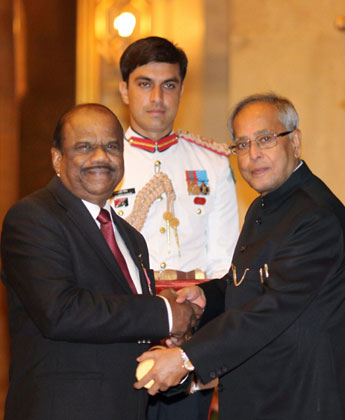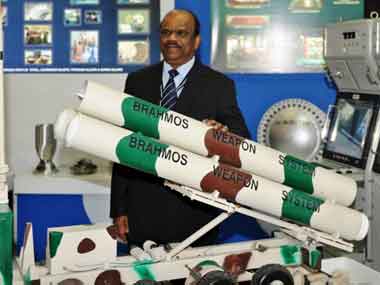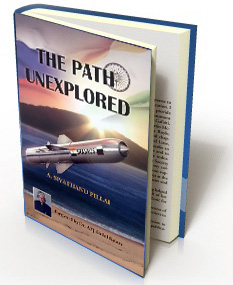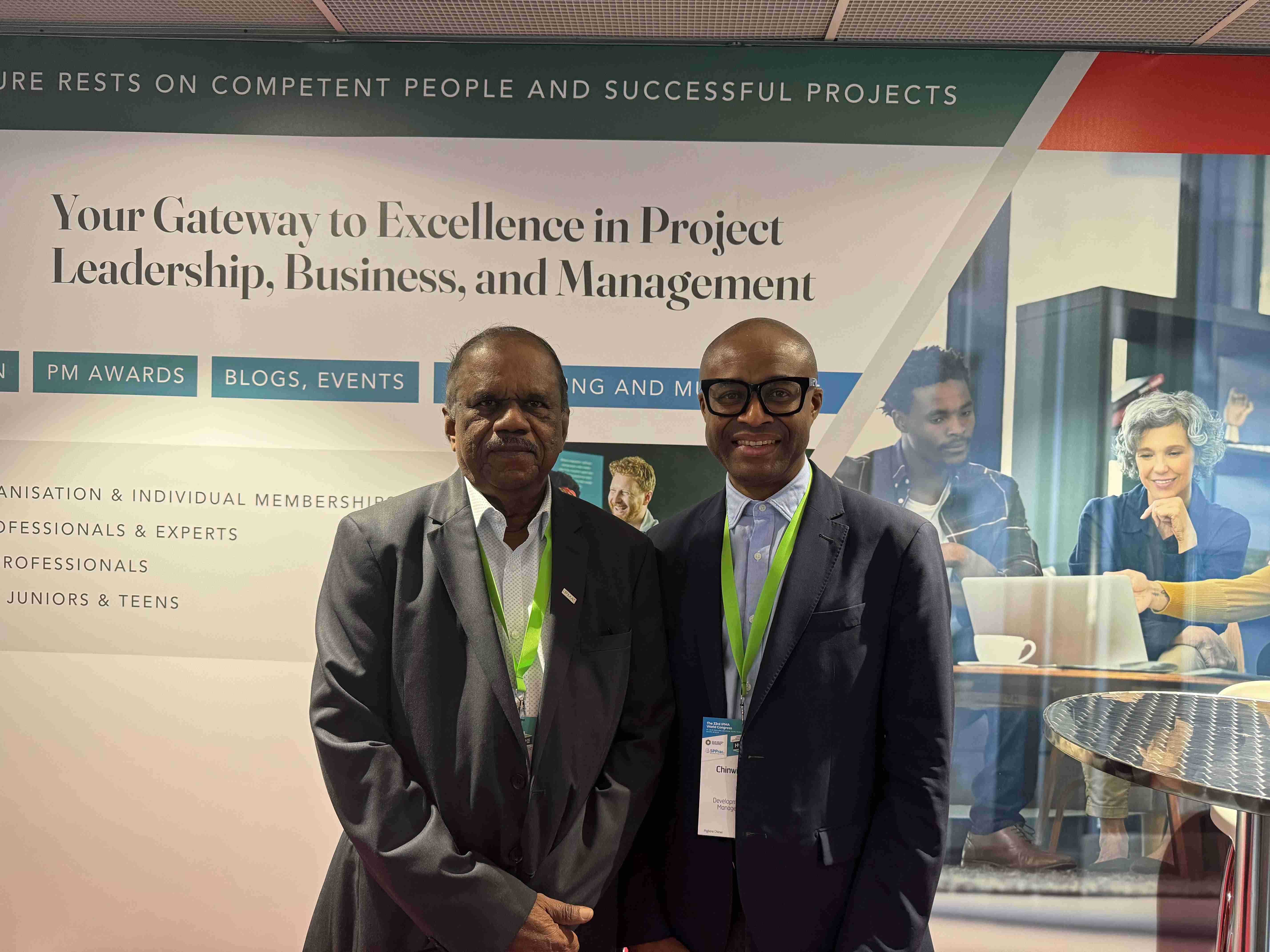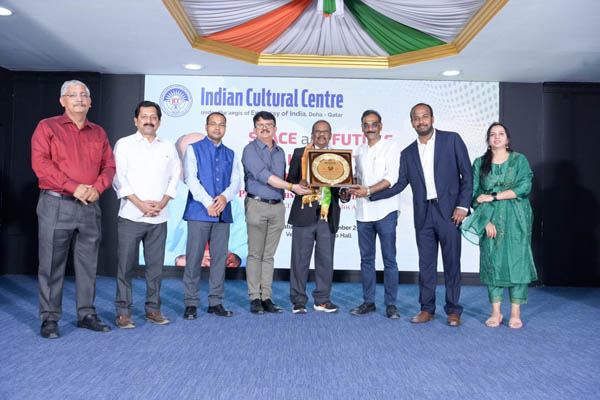6th Convocation Address
Meenakshi Academy of Higher Education and Research
30 November 2012
By
Dr. A. Sivathanu Pillai
Distinguished Scientist & Chief Controller R&D, DRDO & CEO&MD, BrahMos Aerospace
Compassion with Character – Need for value based Education and Research
Shri AN Radhakrishnan, Chancellor, Dr. A. Gnanam, Pro Chancellor, Prof. R Venkataswami, Member of Board of Management, Dr. P Jayakumar, Vice Chancellor I/c., faculty members, and the most distinguished personalities on the dais, Invitees, Guests, Graduates, Students, Ladies and Gentlemen, my greetings to you all.
I am indeed delighted to participate in the 6th Convocation Ceremony of the Meenakshi Academy of Higher Education and Research. I thank Dr. Venkataswami and the Chancellor for giving me the opportunity to share this moment of joy and celebration with the Graduates, here. I extend my special greetings to the proud parents of the students who are graduating today, whose unflinching dedication and support have made it possible for their success.
During this evolution of the universe, galaxies, solar system and the earth, life started coming from a single cell organism Amoeba to the sixth sensed human being. Human being is a special creation of the creator. Therefore, the life of the human being is highly valuable in all the creations. We are grateful to the creator for giving us this precious life to live through. Such a life with its structure the body has to be defect free if we have to use the full potential of the birth. As the famous poetess Avvaiyar says:
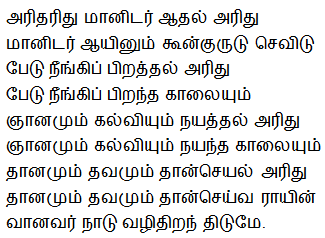
My dear Graduates, you are at this point of life where you are going to start your medical career as profession. You have the great responsibility next to the creator God, to protect everybody, making them free from defects & diseases. Medical profession is such a noble profession. When it is supplemented with compassion, then the service rendered by you becomes godly service. Hence, I have chosen the topic “Compassion with Character”.
GREAT SCENE WHICH IMPRESSED ME IN MY LIFE
When I talked about the Compassion, I remember my Father who was a Siddha Practitioner. I would like to narrate an incident that had happened when I was a school boy. I was sitting on the verandah of my house in a village near Nagercoil and I saw suddenly a white car coming and parked in front of my house. A Gentleman in middle 50s got down and asked for my father. Without knowing the purpose, I took him to my father. He touched the feet of my father and explained the purpose of the meeting. Heard about my father from his relatives at Tirunelveli, he came from Chennai and told my father that his wife was suffering from Blood Cancer and the Doctors had told him that her chance of survival was only for the next 15 days. Tears poured from his eyes. He surrendered himself to my father and said that he only can cure his wife. My Father without telling anything got ready in 10 minutes and went with him in the car. After reaching his place, he prepared her medicines and food in the form of pashpams dealt with poisonous materials like arsenic and mercury, prepared with extreme care. He was there for a week and took care of that lady. He asked the gentleman to continue the medicines and food and as prescribed by him and said she will be alright in a week. After that my father returned to our place. Two weeks later, the same gentleman came and fell flat in front of my father and told that he showed his wife to the doctors and they got astonished that there was no sign of cancer in her. He gave a box to my father as ¸¡½¢ì¨¸ (Kanikkai). My father asked what is that? He said some money as gratitude. My father said that he was there to cure the lady, not for the money and told him to take the money back.
The selflessness nature of the doctor and the treatment of patients with compassion are the essential requirements which will make you great further in your noble profession.
Aryabhatta, Charaka, Sushruta, Panini, etc., were some of the eminent scientists of the ancient era. These scientists evolved many mathematical and scientific theories that can be proved using current methods. The saints and sages invented and discovered many new scientific breakthroughs. Aryabhatta (476 AD) was the first to proclaim that the earth is round and rotates on its axis. He is also acknowledged for calculating the value of ? (Pi) to 3.1416 and sine table in trigonometry; Bhaskaracharya II (1114–1183 AD) was first to discover gravity 500 years before Sir Isaac Newton; Acharya Kanad (600 BC) said "Every object of creation is made of atoms which in turn connect with each other to form molecules”; Acharya Sushrut (600 BC) performed Rhinoplasty (restoration of a damaged nose) and prescribed treatment for 12 types of fractures and six types of dislocations; Acharya Charak (600 BC) described the medicinal qualities and functions of 100,000 herbal plants; Acharya Bhardwaj (800 BC) designed and described the techniques of aviation technology; and Acharya Kapil (3000 BC) outlined the concept of transformation of energy.
When we are at Kancheepuram, we remember of the Great Pallava Kingdom for which Kancheepuram was the capital. We also learn that Bodhi Dharma, the third son of Pallava King of Kancheepuram in South India during fifth century went all the way to China to help the people with his knowledge of herbal medicines for curing unknown dreaded diseases and with his knowledge of martial arts protected them from the tribal war. He taught martial arts to the Chinese through his teachings and established the famous Shaolin temple. In the recent movie 7am Arivu, the dNA Characterisation to reproduce the capabilities of Bodhi Dharma to his generation is a revolution.
You and me belong to a great gene, which nurtured science and technology, medicine, unique culture and value system in the yester years for the world. We have to activate the DNA to perform the best to make India a global leader. We have made advancements in many fields to become a player in the international world. Many more things have to be done.
MY GREAT TEACHERS
Friends, after my graduation, I started my career in the Indian Space Research Organisation. I was fortunate to work with Dr. Vikram Sarabhai to evolve the 10 year space profile for ISRO. Then I became a core team member of the SLV-3 under the leadership of Dr. Kalam, with the responsibility of design and development of first stage rocket booster for our First Indigenous Satellite Launch Vehicle SLV-3. Later I worked with Prof. Satish Dhawan in Launch vehicle configuration. I was fortunate to work with three leaders of India’s aerospace and missile programmes – Dr. Vikram Sarabhai, Prof. Satish Dhawan and Dr. Abdul Kalam. I believe that there is a lot to learn from the experiences of great leaders and it is the wisdom of these experiences which others can inculcate in becoming successful leaders. Vikram Sarabhai was an excellent team builder, giving technological challenges to scientists and demanding more of them all the time. He was building creative leaders in multiple disciplines. Prof. Satish Dhawan channelised the vision of Sarabhai for self-sufficiency in launch vehicle technology and satellites into missions and goals. I had a privilege of working with Dr. APJ Abdul Kalam for more than three decades. Dr. Kalam piloted the development of indigenous guided missile systems. He has immaculate vision for the empowerment of the nation through high technology and initiated Guided Missile Programme with a vision to make India self sufficient and self reliant in state-of-the-art high technologies in the year 1983. In the era of technology denials and control regimes, it was indeed a difficult mission. Dr. Kalam was one of the few leaders who always visualised the risks associated with the development and prepared the team to face failures and transform them into successes.
MISSILES
I would like to highlight few examples from India’s missile programme, how we achieved self-reliance in critical technology, using network of academia, R&D Labs and Industry with innovative young minds.
Agni & Supercomputer
India’s long range guided missile is Agni, the Intermediate Range Ballistic Missile. In its trajectory, it flies to an altitude of 600 kms and flies back to the target point, re-entering the earth’s atmosphere. Re-entry is a very important technology, as the re-entry module has to withstand 3000°C at the point of crossing the atmosphere. Choice of material, shape of the re-entry module, guidance and control algorithm, capability for electronics systems to withstand the high speed and the temperature conditions are the important aspects during re-entry. The technique use for designing the shape of the re-entry module was Computational Fluid Dynamics with elaborate software codes to analyze the response of more than 100,000 grid points in the structure. Supercomputer can do the iteration using a fast algorithm, without which, it would take 9 days for the analysis. A two pronged approach was initiated with a group of young scientists to evolve new CFD codes and another group of young scientists to develop a supercomputer. Within 24 months the team came out with a solution to reduce each iteration time from 9 days to 5 minutes, using the fastest Supercomputer PACE++ parallel processor, which was 20 times faster than the Cray XMP Computer, which was refused to us. The CFD effort resulted a top class CFD centre in the campus of Indian Institute of Science. Networking of Academy and R&D Labs and using fresh young minds from the Universities have tremendously helped to overcome the Technology denial regime instituted by few developed Nations. India proved its might with innovative young minds.
BrahMos Supersonic Cruise Missile – The Brahmastra
The Gulf Wars from 1991 gave us the message that cruise missiles are very important to destroy the enemies’ assets on the first day, without giving time for the enemy to respond. Cruise missiles are stealthy, fly at very low altitude and very precise to hit the target. American Tomahawk missiles were dominant during the Gulf Wars, but it has a subsonic speed (i.e. speed less than that of sound). India decided to go for cruise missile development, with a difference. When the whole world was using subsonic cruise missiles, India decided to go for supersonic cruise missile, 3 times faster than the sound. To cut short the time of development and inherit very high level of technology, India joined hands with Russia making the BrahMos joint venture. BrahMos is responsible to design, develop, produce and market a world class cruise missile. A new generation of young scientists from the Indian institutions with the help of experienced Russian specialists, formed a consortium with industries of India and Russia, made it possible to create a wonderful product, i.e. BRAHMOS. It is a supersonic cruise missile, which can be launched from any platform on land, on sea, underwater and in air with multiple missions against land and sea targets. The unique nature of BRAHMOS with its universality made Indian Armed Forces, the first in the world to possess supersonic cruise missiles. Various versions of BRAHMOS have been developed, produced and inducted in the Indian Armed Forces on ships and on land. The developed world got astonished to see the Indian might through this Brahmastra. We together established that “We can do it”.
Hypersonic Reusable Cruise Missile–The Sudharshan Chakra
Lord Krishna took Viswaroop at Kurukshetra, with his mighty ever-moving Sudharshan Chakra on his right index finger. The importance of Sudharshan Chakra was its ever readiness to destroy the enemy and come back. If this is so, the idea came to us that why not we create a hypersonic cruise missile which destroys the target and flies back to us for re-use. Going at a speed of Mach 7, deliver the warhead, assess the destruction of the target, come back and get ready to go again, i.e. Hypersonic Reusable Cruise Missile, the next version of Sudharshan Chakra. This is the BrahMos-II programme and it has been started with its design and basic technology development. Our dream of achieving this extraordinary project will come true with the help of youngsters like you.
DEFENCE TECHNOLOGY SPINOFFS
The Indian missile programme has given important spin off technologies, particularly for healthcare at affordable cost. One among them is Floor Reaction Orthosis (FRO). FRO is the modern remedy for the polio patients whose quadriceps muscles are paralyzed. Compared to conventional 3 kg caliper, FRO weighs only 300 gm and costs half. There was a necessity for standardization, process upgradation and productionisation of FRO with due clinical validation in order to cater the pressing need of the large number of children affected by polio. Today more than 40000 of such children have been fitted with the FROs. The introduction of indigenous stents made from the material used in missile projects, helped to bring down the cost to a one fifth of its original cost. Anamica - 3-D medical visualisation software enables the doctors to simulate the surgery on their computers. Aspheric magnifier is useful for improving the vision of the visually impaired. An ophthalmic laser (Nd-Yag) photo disruptor known as Drishti-1064 developed at 1/3rd cost compared to imported one, is used for capsulotomy and iridotomy. The new treatment modality to use 2 Deoxy-D Glucose as a radio sensitizer for cancer therapy has also been developed. The Typhoid Test Kit is useful for testing typhoid infection at any place within 3 minutes. Cytoscan for early cancer detection, external cardiac pacemaker, Titanium Dental implants, hip joints, Herbal Ointment for anti-vitiligo and Eczema, are all missile technology spin-offs. A simple light weight foldable stretcher made of composite material has been developed for application in all hospitals. Sanjeevani, an acoustic detector from sonar technology, is a lifesaver in natural calamities such as earthquakes, avalanches, etc. This has been used to save the lives of people buried under debris during earthquake in Gujarat.
INNOVATIONS
Innovations are part of the development of the society. Great scientific inventions during the last four centuries have transformed the quality of our life. If innovations are not there, then the inventions will not be there. When we see the electric bulb giving light, our thoughts instantly go to the inventor Thomas Alva Edison. When we hear the sound of an aeroplane, our thoughts go to Wright brothers who disproved Kelvin’s assertive statement “Heavier than air flying machines are impossible”. The telephone reminds us of Alexander Graham Bell. The list is not exhaustive.
Innovations by People
I would like to narrate about the services rendered by some of the people towards the society by their innovation.
Prof. R Venkataswami who is sitting here is known for his contributions in the medical field and is regarded as the Father of Micro Surgery on Hand Reconstruction in India. An alumnus of Stanley Medical College, he established Institute for the Research and Rehabilitation of Hand and the Department of Plastic Surgery at Stanley Medical College.
You are aware of Dr. Shanta, a renowned Cancer specialist who had founded the Cancer Institute at Chennai. Dr. Shanta also set up India’s first comprehensive paediatric cancer clinic, conducted the country’s first major cancer survey, and developed its first programme for the early detection of cancer in rural areas. She became a passionate advocate of cancer prevention and opened a tobacco cessation clinic. She conducted India’s first successful trials of combination therapy, leading to a dramatic breakthrough in the control and cure of oral cancer. Today, this cancer institute has grown to 428 bed hospital with advanced specialties in medical, surgical, and radiation oncology. She strives to ensure that the Institute remains true to its ethos, " Service to all."
As a proud father, I would like to mention about my son Dr. Bhagawath Kumar. Dr. Kumar is a Plastic Surgeon specialised in micro surgery is a disciple of Prof. Venkataswami. He got his M.Ch from Stanley and Fellowship in USA. He was associated with Dr. Gazi Yasargil, one of the greatest neurosurgeons of the twentieth century and the Surgeon of the Millennium. One of his accomplishments was the replacement of big finger. The patient who came to him lost all his fingers at right hand, in an accident. Dr. Kumar performed micro surgery and transplanted the portion of fingers from the patient’s leg and grafted on the hand.
Recent Developments & Technological Innovation
Stem Cell Applications
The ultimate aim of bio scientists and technologists is to rebuild or replace injured or diseased tissues/organs that cannot heal naturally, through stem cell research. This would be accomplished by transplanting stem cells into the damaged area and directing them to grow a new healthy tissue. Applications of stem cell therapy include gene therapy, repair of damaged heart muscle, restoration of vision, treatment of diabetes, etc. Aarohi a four-month-old child who was suffering from Alcapa (anomalous origin of left coronary artery from pulmonary artery) underwent stem cell therapy at Frontier Lifeline Hospitals, Chennai. This therapy was unique and the first of its kind in the country.
Bio Chip for Parkinson’s disease
Wireless system linked with the bio chip in the brain has been developed for possible treatment of Parkinson’s disease, Alzheimer and Epilepsy. The primary symptoms in Parkinson’s disease are trembling in hands, arms, legs, jaw and face, rigidity or stiffness of the limbs, slowness of movement and impaired balance. The tremor is measured by a passive polymer based sensor on the wrist near the tremor location. The sensor gets power from a pacemaker which also reads tremor motion. The pacemaker then generates a pulse in the implanted device in the brain to activate neurons. Once the neurons are activated, the tremor is controlled.
Convergence of Technology
The information technology and communication technology have already converged leading to Information and Communication Technology (ICT). Information Technology combined with biotechnology has led to bioinformatics. Similarly, Photonics is grown out from the labs to converge with classical Electronics and Microelectronics to bring in new high speed options in consumer products. Flexible and unbreakable displays using thin layer of film on transparent polymers have emerged as new symbols of entertainment and media tools. Nanotechnology is the field of the future that will replace microelectronics and many fields with tremendous application potential in the areas of medicine, electronics and material science.
When Nano technology and ICT meet, integrated silicon electronics, photonics are born and it can be said that material convergence will happen. With material convergence and biotechnology linked, a new science called Intelligent Bioscience will be born which would lead to a disease free and more intelligent human habitat with longevity and high human capabilities. Convergence of bio-nano-info technologies can lead to the development of nano devices like nano robots. When Nano robots are injected into a patient, it will diagnose and deliver the treatment exclusively in the affected area and then the nanorobot gets digested as it is a DNA based product. Drug delivery system will revolutionize the healthcare to a large extent. Nanosensor based smart drug delivery systems discharge drug in appropriate quantity and at right time. Nano Bio medical sensors will play a major role in glucose detection and endoscopic implants. Immuno assays can be used for detecting antigens in blood samples by introduction of nanoshells attached to anti bodies while sampling blood. Similarly, the nanotechnologies offer a wide range of opportunities such as synthetic scaffolding and nanoceramic coatings for tissue repair and implants respectively. Dip pen nanolithography is a latest nanofabrication method which uses microscopic tips coated with a material which can be metals, DNA, proteins that is deposited as ‘ink’ on a wide range of surfaces such as silicon, glass or metal. Convergence of technologies opens up new areas for research and ultimately results in the betterment of the human beings.
New Technologies in Healthcare
Applications of nanotechnology are currently being developed for a broad range of therapeutic applications. It is expected that over the next five years nanotechnology will result in significant, and perhaps paradigm-changing, advances in early detection, molecular imaging, assessment of therapeutic efficacy, targeted and multifunctional therapeutics, and prevention and control of diseases e.g. cancer, TB, etc. Specific tissue targeting of nanoparticles for diagnostic purposes or drug delivery is being pursued on a number of fronts. Many types of cells and tissues can be distinguished on the basis of extracellular markers. Homing peptides, ligands that attach to nanoparticles and direct them to recognize specific extracellular markers are being developed for a wide range of cell types. The vasculature is an attractive tissue for targeting efforts, because malignant tumors must recruit their own blood supply in order to sustain their uninhibited growth. Tumor vasculature can usually be distinguished from normal blood vessels, permitting the development of specific, targeted therapeutics to attack and cut off tumors’ critical blood supplies.
Other delivery systems employ nanotubes, developed by material scientists that are used to increase the strength and elasticity of plastics and other materials. These nanotubes have been shown to be capable of crossing cell membranes and ferrying proteins into cells. Because eliminating specific RNA molecules has been shown to downregulate cancer growth, attaching RNA-degrading enzymes or antisense molecules (RNA or DNA that interfere with gene expression) to nanotubes is one approach under development. In one recent study, complexing antisense DNA with gold nanoparticles was demonstrated to boost delivery into cancer cells. In addition, the antisense molecules also bound to their targets more efficiently.
Nanotechnology-based diagnostic and therapeutic tools are also being developed for medical conditions such as cardiac disease and neurological disorders. Because they can cross the blood-brain barrier, nanoparticles hold particular promise for efficient drug delivery systems for brain disorders. In one recent study, an analgesic drug attached to albumin nanoparticles was successfully delivered to the brains of mice.
Nanoparticles find many applications in curing the dreaded diseases. Scientists at MIT have designed a new type of nanoparticle that could deliver vaccines effectively for diseases like HIV, Malaria. Synthetic Protein vaccines are covered by fatty droplets called liposomes which increase the T-cell response. Once absorbed by a cell, these droplets degrade quickly and release vaccine and provoke T cell response. These are at the trial stage and soon this would be a reality in treating the human beings affected with HIV and Malaria.
Nano Bio medical sensors will play a major role in early detection of dreaded diseases like AIDS and cancer. Immuno assays can be used for detecting antigens in blood samples by introduction of nanoshells attached to antibodies while sampling blood. Nanomagnetic particles can be used for targeted treatment and diagnosis. Nanosensor based smart drug delivery systems discharge drugs in appropriate quantity and at the right time. Similarly, nanotechnology offers a wide range of opportunities such as synthetic scaffolding and nanoceramic coatings for tissue repair and implants respectively.
Artificial neural network out of DNA
Recently, the Researchers of California Institute of Technology have created the first Artificial Neural Network out of DNA, creating a circuit of interacting molecules that can recall memories based on incomplete patterns, just as a brain can. The neural network was built of four neurons made up of 112 distinct DNA strands (by contrast, the human brain has some 100 billion neurons). This DNA-based neural network demonstrates the ability to take an incomplete pattern and figure out what it might represent—one of the brain's unique features. According to the researchers, biochemical systems with artificial intelligence (or at least some basic, decision-making capabilities) could have powerful applications in medicine, chemistry, and biological research in answering fundamental biological questions or diagnose a disease. Duplicating of Human Brain is not far with the nano revolution.
DEDICATION AND COMPASSION
One should have concern for the society and the people around them. Social concern begins from within us and from where we are and what we have. Social concern involves discovering more of ourselves and our capabilities as we share what little we can give of our gifts. It further rests in the realization that the smallest efforts we exert will eventually bear bigger and better fruits. Dedication and compassion are the most important aspects of serving the society. I would like to quote Mother Teresa’s saying:
“I slept and I dreamed that life is all joy,
I woke and I saw that life is all service.
I served and I saw that service is joy.”
- Mother Teresa
Mother Teresa devoted herself to work among the poorest of the poor in the slums of Calcutta. She believed that the greatest way to show God's love is to meet the needs of others. Although she had no funds, she depended on Divine Providence, and started an open-air school for slum children. Soon she was joined by voluntary helpers, and financial support was also forthcoming. This made it possible for her to extend the scope of her work. It would be true to say that her dedication to help those who couldn't help themselves has been an inspiration to the world. Her greatest impact on society was to bring an awareness that love is worth nothing unless it is given for free. She taught people that Love will open doors that Hate has closed.
CONCLUSION
Technology can affect the most fundamental changes in the ground rules of economic competitiveness and societal prosperity for any country. Technology is Neutral - Neither good nor evil. It is up to us to breathe the moral and ethical life into these technologies and then apply them with compassion towards each and every patient. Healers have always occupied a very special place in society – not only of the wounded body, but also of wounded hearts, minds and souls. The exciting advances in medical science are opening up a world of unimaginable and enormous possibilities for us to defeat the age-old scourge of disease. We continue to witness human sufferings due to the dreaded diseases. You are greatly privileged to be part of a very important section of our society to be able to reduce the pain of the society in curing such complicated diseases. As young medical professionals, you have to use and apply new, powerful and exciting medical technologies in socially responsible ways to bring new cures to those who need them the most, at an affordable cost and reduced pain to the patients.
May the blessings of the almighty be with you, in performing and succeeding in your noble task of healing the pain of the people and bring solace and happiness to millions of fellow human beings.
I would like to conclude with the sayings of Gandhiji and Maharishi Patanchali:
Mahatma Gandhi once told,
“Men often become what they believe themselves to be. If I believe I cannot do something, it makes me incapable of doing it. But when I believe I can, then I acquire the ability to do it, even I did not have it in the beginning.”
Saint Patanchali in his yoga sutra says,
“When you are inspired by some great purpose, some extraordinary work, all your thoughts break their bounds, your mind transcends limitations, your consciousness expands in every direction and you will find yourself in a new great and wonderful world. Dormant forces, faculties and talents become alive and you discover yourself to be a greater person by far than you ever dreamt yourself to be.”
I congratulate you all and wish you all the best in the future.




